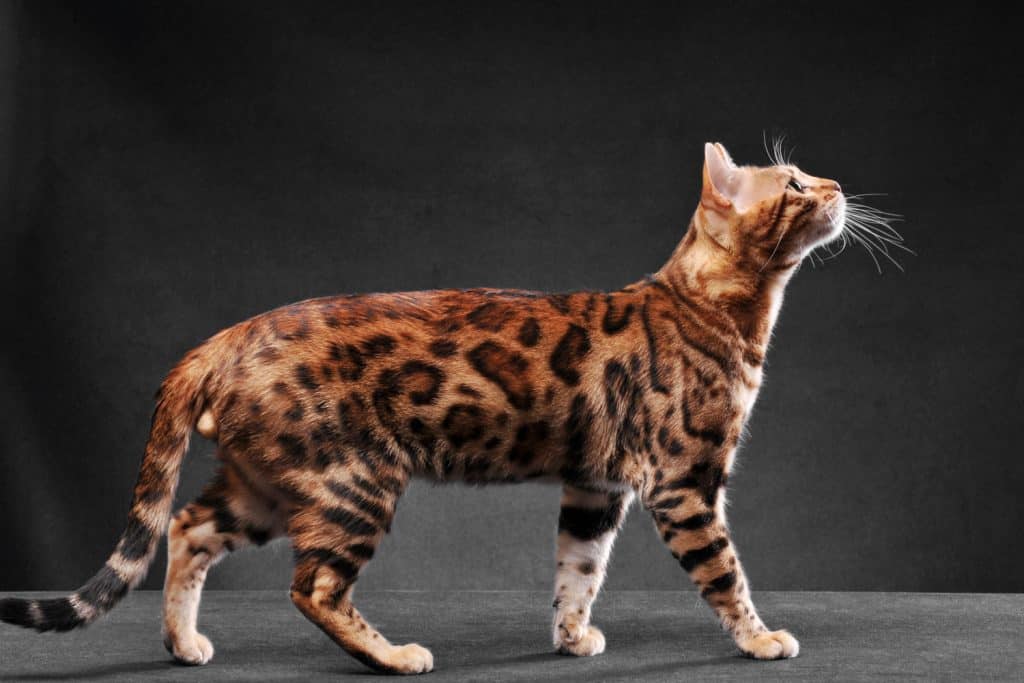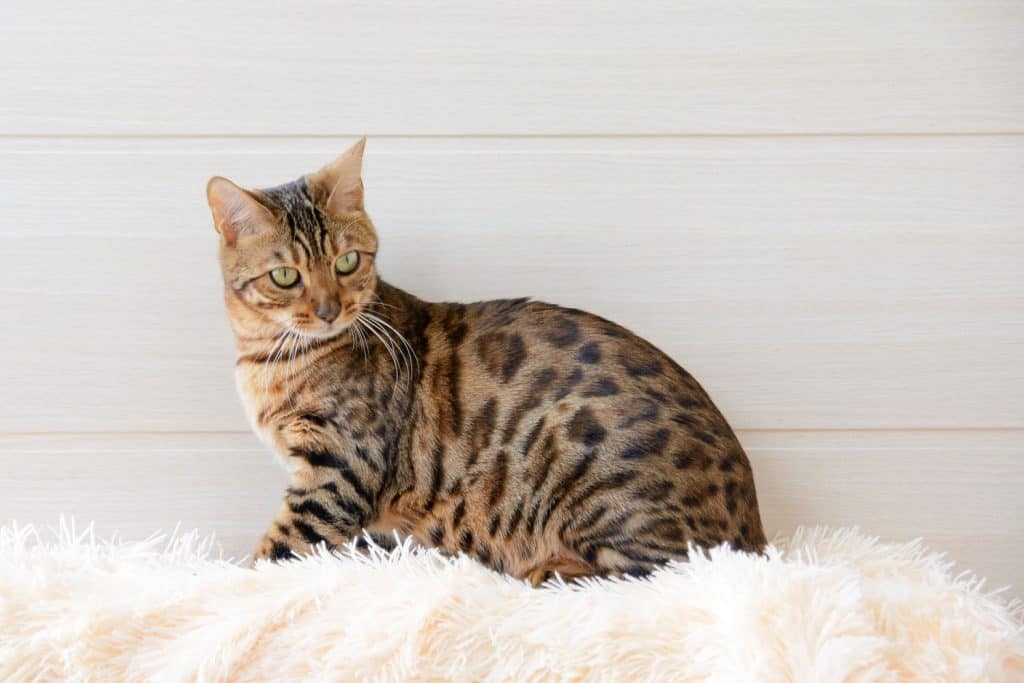Bengal cats are a highly popular breed known for their spectacular spots. These felines have a marvelous spotted coat reminiscent of wild ocelots or leopards. However, they may not be a great match for everyone since some owners report aggressive behavior in Bengals. We've done the research to help you figure out if these cats are truly violent or simply misunderstood.
Bengal cats are domesticated cats, so they are no more aggressive than an average housecat. However, they are highly energetic and territorial, which can produce violent tendencies. These cats are loving and loyal companions as long as they are trained, socialized, and satisfied.
Although these cats seem like wild creatures, they are playful and friendly creatures on the inside. With that said, you may still want to know about their aggressive side. How do you calm down a Bengal? Are they a great match for you? Continue reading to discover all there is to know about a Bengal cat's aggressive behavior.
![A Bengal cat sitting on the bed looking at something, Are Bengal Cats Aggressive? [Inc. With Other Cats]](https://meowhoo.com/wp-content/uploads/2021/10/Are-Bengal-Cats-Aggressive-Inc.-With-Other-Cats-683x1024.png)
How Aggressive Are Bengal Cats?
To understand a Bengal cat’s temperament, it would be best to learn about their history first. Bengal cats are a hybrid between Asian leopard cats and domestic shorthairs, which produces a unique but challenging personality.
Bengal cats are classified by how many generations they are separate from their wild counterparts. The kitten of the Asian leopard cat is called F1, and every generation afterward is called F2, F3, and so on.
To be considered domesticated, the Bengal you own should be classified as F4 or further. Due to being of hybrid breed and wild genes, Bengal cats may develop behavioral and health issues especially due to owners being underprepared and unable to fulfill all their feline’s needs.
Bengal cats are playful felines. According to Blind Bengal, these cats are occasionally destructive and may bite or jump at their owners.
However, Bengals show this behavior, not due to aggressiveness but because they are naturally curious and attention-seeking. Bengal cats will do anything to get their owners’ attention when they get bored.
How Do You Calm An Aggressive Bengal Cat?

You can avoid or solve a Bengal's behavioral problems when they arise by fulfilling your cat’s needs for lots of attention, interactive toys, enough climbing space, and proper training.
As said before, Bengal cats love attention and play. You can fulfill their playing and adventure needs by training them to walk on leashes and taking them outside.
You can also take advantage of their inquisitive nature by purchasing interactive puzzle toys that dispense treats to keep them occupied. If you are adopting or buying a Bengal kitten, you can train them to play and socialize with other pets at home so that they can stave off their boredom.
Alternatively, you can buy or purchase two Bengal cats at once and train them to cohabitate and socialize in your home. The key in successfully integrating a Bengal cat into your home is to socialize and expose them at a very young age with family members, children, and other pets to avoid aggressiveness.
Akin to their ancestors in the wild, Bengal cats love climbing and water. Providing your Bengal with a cat tree and a pet fountain can keep your Bengal cat busy and will keep them from destroying your couch.
To find the best place to put your cat tree, check out this helpful article: Where To Place A Cat Tree
Do Bengals Calm Down After Neutering?
Neutering and spaying are important health procedures that can change the behavior of a cat. In general, neutering and spaying cats reduces sexual-related behavior such as attracting unaltered cats and aggression.
After neutering, your Bengal cat’s unwanted sexual behaviors and aggression will go away. There is also a chance that your male Bengal will become more docile.
However, your Bengal cat’s playfulness and activity are not sexual behaviors. After neutering or spaying, your cat will still be as energetic and hyper as it was before alteration.
Why Are Bengal Cats So Hyper?
A Bengal cat’s hyperactivity is innate to its breed. They are well-known not only for their beautiful spots but also for their playful and energetic nature.
Why Shouldn’t You Get A Bengal Cat?

Bengal cats are eccentric creatures, to say the least, due to their temperament. As such, they are not good companions for people looking for cats that sleep on their laps most of the time.
You should not get a Bengal cat if you are often away from home, dislike training, and have little space for climbing.
Bengal cats are perfectly suited for active owners that spend most of their time at home. These owners are best for Bengals since the cats love taking walks and get bored easily when left alone.
According to VetStreet, Bengal cats demand a lot of attention. So much so that they are willing to bite, scratch, claw your leg, or anything else you do not like them to do if it means you will interact with them.
If you are thinking of other reasons why your Bengal cat is clawing your leg, check out this post: Why Does My Cat Claw My Leg?
A Bengal cat’s boredom can make them aggressive and destructive, although often unintentionally. As they enjoy climbing, Bengal cats often go up shelves and push everything in its path off the surface.
Bengals may also have difficulty living with other animals since they are very territorial creatures. However, they can be friendly with dogs and other cats if they have been trained to socialize at an early age.
Why Does My Bengal Cat Attack My Other Cat?
Your Bengal cat may seem like they are attacking your other cat, but that is not often the case. Cats often play by mimicking their ancestors’ hunting and chasing activities, like pouncing, biting each other, or scratching each other’s noses.
Since they are playful and energetic, Bengal cats may seem more aggressive when compared to your other cat. However, if you see signs of violence such as puffed tail fur, ears held back, or baring teeth, then you might have to step in.
This kind of aggression coming from your Bengal can come from improper training, late socializing, or inadequate exposure to the other cat. The aggression may also come from your Bengal cat having little or nothing to do.
How Do You Stop Bengal Cats From Attacking?
If your Bengal cat is play-biting or scratching you, the best thing you can do is to wear a long-sleeved shirt, jacket, or pants to protect your skin.
You can redirect its attention by throwing a soft toy it can bite on or scratch on with its claws.
However, your approach should be different when your Bengal cat is beginning to show signs of aggression such as baring its teeth or hissing. Your approach to stopping your cat depends on how and why it’s showing aggression in the first place.
If the cat seems fearful or threatened, leave them alone. If your cat seems angry or defensive, try using distractions such as toys or a loud sound to break the anger trance.
If your Bengal cat is attacking another cat, it would be best to place them in separate rooms or put a barrier in between them if they must share the same place.
You should observe your Bengal to see what triggers its aggression. Is it because of territory, unfamiliarity, or competing for your attention?
Once you figure out your Bengal’s triggers, you should prevent them to reduce instances of aggression and violence. You can then slowly reintroduce your cats to each other by allowing some interaction and gradually increasing their access to each other.
However, in no instance should you hit or inflict pain on your Bengal cat. It will break your cat’s trust and may cause them to be angrier and more aggressive towards you or your other cat.
In Closing
Bengal cats are lively, energetic felines that love getting attention. This attention-seeking personality makes them seem aggressive at first glance, but they may actually just be playing.
However, Bengal cats may develop behavioral and aggression issues if their needs are being neglected. By providing them with lots of toys to play with, a place to climb, and hours of attention and activity, you will get to enjoy a playful, loving, loyal companion that looks like a miniature leopard straight from the jungle.
Some elements on this page may have been created by our team using advanced AI to provide you with top-notch cat inspired ideas. Read more about our AI Content Policy.
